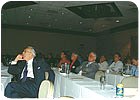
The Copper Development Association (CDA) hosted a two-day conference Sept. 13-14, 2007, in Oak Brook, IL, focusing on global market trends and the effect they have on the future of the copper industry. Among the 10 featured sessions were discussions on copper sustainability and substitution, the global economic outlook, energy-conserving technologies and a legislative update on lead in plumbing.

Copper Sustainability
Dr. Robert Ayres, professor emeritus, Environment & Management, INSEAD graduate business school, reassured the audience of CDA members and copper industry professionals that we have not yet exhausted the earth’s supply of copper, and he predicted that it will be many years before there is any need to worry about coming to the end of our deposits.“When I began preparing for this lecture, I thought that peak copper would be visible on the horizon,” Dr. Ayres stated in his presentation. “It is not. There is more copper still to be discovered than I would have guessed.”
Furthermore, Dr. Ayres noted, “Growth can continue for the foreseeable future (several decades at least) before the peak.”
This was good news to the copper tubing and wire manufacturers in the audience, as was Dr. Ayres’ reassurance that “copper is as essential to the world economy as any metal, more than most.”
Dr. Ayres also addressed the suitability of copper substitutes on the market, saying that “for domestic wiring and plumbing, and for most small appliances, copper is replaceable (by aluminum) only at significant loss of performance and flexibility.” Where small size matters, Dr. Ayres said, copper is unbeatable.
The demand is on the rise as well, he noted, stating that the demand for new housing in Europe and the U.S., as well as for “400 rural immigrants to cities in China, alone, is enough to create a huge potential demand for billions of pounds of copper plumbing and wiring.”
Another source of growing copper demand, he noted, is the replacement of the obsolete lead water pipes with copper in millions of older European homes and apartment houses.
The biggest challenge to the copper industry, Dr. Ayres said, is “to increase the recycling rate, now barely 40%. Apart from other issues, open pit mining and the rest of the processing cycle are environmentally damaging. More restrictions are inevitable.”

Recession On The Horizon
On a darker note, economist Mark Zandi from Moody’s/Economy.com offered a less encouraging analysis of the global economy, as well as the national economic outlook.Zandi stated that although he was optimistic that an economic recession for the U.S. is not imminent, he also noted that analysts had calculated a 40% probability that a recession may indeed be on the horizon in as little as six to 12 months. Zandi said that analysts attribute this prediction to several factors, including the rising cost of capital, the limited availability of credit, a credit crunch in residential mortgage lending just as mortgage resets are hitting their peak, and the falling rate of housing starts and house prices.
Zandi predicted that the next three quarters in the housing market will be weak. He noted that homeowners are relenting on their mortgages due to the rising mortgage rates, and then these foreclosed houses are put back on the market, slowing new housing construction. In addition, he noted, personal savings rates are down for homeowners who have taken out equity loans, so they are significantly holding back on their spending.
However, Zandi listed several reasons why he feels the economy will struggle, but not go into recession. He noted that outside of housing-related industries, the auto market, print media and national and global business are all doing well and margins are wide in these areas, so they remain profitably high. He says that profit growth will slow down, but it will just be a pause. He also noted that businesses are very liquid, with a lot of cash to weather a period of weak sales without having to pull back on purchasing. Trade has swung from a negative to a positive, adding to the gross domestic product, he said, and the dollar being down helps with international trade, promoting more export growth and less import growth. The Federal Reserve will ease, interest rates will go down, and FHA lending will increase to aid the homeowners with loan delinquency.
“All eyes should be on business confidence,” Zandi noted. He said the way to avoid recession is to keep consumer spending up. If consumers start to worry about losing their jobs, he said, then they won’t spend, and then the owners worry about not selling, so they lay off workers, bringing about the recession.
Business confidence has to turn from a negative to a positive, Zandi said, and copper prices have to stay high to stave off a recession.

Turning To Cleaner Fuels
Ron Pernick, co-founder and principal of Clean Edge, a research and publishing firm focused on clean technologies, explained the “Clean Tech Revolution,” to the CDA meeting attendees. Pernick said that the intention of Clean Tech is to harness renewable materials and energy sources, reduce the use of non-renewable natural resources, cut or eliminate emissions and waste, while also delivering equal, if not superior, performance to conventional offerings. What Clean Tech is not, he noted, is nuclear or coal-fueled power.Clean Tech fuels include things like biofuels, fuel cells, geothermal, solar-photovoltaics, wind power, a smart energy grid, biological water filtration, distributed systems, small-scale desalination, ultraviolet purification, nanotech-based filtration and materials, green buildings, green chemistry and phytoremediation, among others.
The driving forces for implementing clean technology include what Pernick calls “The Six Cs,” costs, capital, competition, China, consumers and climate.
The cost of fossil fuels is rising, Pernick said, while clean energy costs are decreasing.
Globally, more capital is being invested in developing cleaner fuels, totaling around $100 billion, he noted.
Cities, states, regions and nations are competing to attract clean tech businesses due to job growth and economic development imperatives. In addition, various countries are competing to convert large portions of their energy reliance to clean technologies by 2030, or in most cases, much earlier.
Consumers are also getting on the clean tech bandwagon, Pernick said, as they move to a more healthy and environmentally safe lifestyle. They are also influenced, he said, by rising gas prices, geopolitical concerns and living green as the new “hip” factor.
And the climate crisis has become more evident, as we’ve seen 11 of the hottest years on record over the past 12 years, as well as the most hurricanes and typhoons ever recorded in 2005, Pernick said, adding that NASA has even reported the Greenland ice belt is melting more quickly than predicted.
What needs to be done? Pernick gave several suggestions: increase the economy of 2 billion cars from 30 mpg to 60 mpg, increase wind power 100-fold to make hydrogen for cars and 50-fold for electricity, increase solar power 700-fold to displace coal, replace 1,400 large coal-fired plants with gas-fired plants, stop all tropical deforestation and plant several million new trees.
Pernick also listed eight tech opportunities for near-to-midterm growth: solar energy, wind power, biofuels and biomaterials, green buildings, personal transportation, “smart grid” grid monitoring intelligence, mobile technologies and water filtration.

Lead In Plumbing Update
Barbara Higgens, executive director for the Plumbing Manufacturers Institute, provided the CDA meeting attendees with an update on the efforts by PMI and its member companies and lobbyists to work with officials in California, Illinois, Michigan and Massachusetts to modify the regulations set forth in recent legislation limiting the use of lead in manufacturing various products, including plumbing fixtures and fittings in some cases. There is also talk of bills underway in Washington state and Vermont addressing these same issues.Higgens reviewed some of the steps that PMI has taken to address the law enacted in California - formerly known as AB 1953 - which restricts lead content in plumbing products through a prescriptive means. PMI has countered with a “Clean Up Bill” - SB 651 - that doesn’t seek to change any of the basic intent of the law, but to clarify the issues regarding product scope, the law’s confusing language, the formula to determine lead content, and the enforcement mechanism, i.e., third-party certification. This bill has been tabled until 2008.
According to Higgens, PMI has also joined with the National Association of Home Builders to secure its political support for future battles and to prevent this from happening in other states.
Meanwhile, Higgens said, Illinois has passed a lead law and Michigan is in the final stages of passing a lead law focused primarily on children’s toys and jewelry. It was announced that some garden hoses were called into question and pulled from the shelves of some stores in Illinois. However, the bill does not seem to affect plumbing products.
On a positive note, in Massachusetts, Higgens said, PMI worked to promote NSF 61, and the Massachusetts Plumbing Board has since moved away from their prescriptive approach and has at last adopted NSF 61 to evaluate products there. In a published statement, they cited this as being the best method of ensuring product compliance.
But the Massachusetts legislature is also considering a bill that calls for a phaseout of 10 chemical-containing products, including lead. PMI’s strategy to oppose the bill includes: 1) Stopping the bill, 2) Seeking exemptions to the bill, 3) Securing amendments to the bill to ensure procedural safeguards, and 4) If passed as is, to appeal to show the hardship and adverse impact of the bill.
On the federal level, Higgens said, discussions continue and it remains to be seen whether the lead legislation will move forward, and if so, how quickly. At this point, there has been no “lead in drinking water measure” introduced in the Senate, but the issue may come up after the EPA has issued its decision on lead and copper in the coming weeks.
